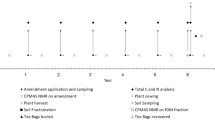Abstract
THE mechanism whereby organic matter, especially the protein moieties, is protected from rapid and complete break-down in soils is not fully understood. The interaction of clay minerals and organic materials with a resultant attenuation in breakdown of these substrates has been reported by a number of workers1. These proposed clay–organic complexes have much to commend them, but they fail to account for a core of resistant organic matter also found in soils which are low in clay minerals. This core of organic matter appears to be either a mixture or a chemical union of lignin-like materials and proteins.
This is a preview of subscription content, access via your institution
Access options
Subscribe to this journal
Receive 51 print issues and online access
$199.00 per year
only $3.90 per issue
Buy this article
- Purchase on Springer Link
- Instant access to full article PDF
Prices may be subject to local taxes which are calculated during checkout
Similar content being viewed by others
References
Lynch, D. L., and Cotnoir, L. J., Soil Sci. Soc. Amer. Proc., 20, 367 (1956). Pinck, L. A., Dyal, R. S., and Allison, E., Soil Sci., 78, 109 (1954).
Waksman, S. A., and Iyer, K. R. N., J. Wash. Acad. Sci., 22, 41 (1932); Soil Sci., 34, 43 (1932). Jensen, H. L., J. Agric. Sci., 19, 71 (1929). Estermann, E. F., and McLaren, A. D., Agronomy Abstracts (1957).
Author information
Authors and Affiliations
Rights and permissions
About this article
Cite this article
LYNCH, D., LYNCH, C. Resistance of Protein–Lignin Complexes, Lignins and Humic Acids to Microbial Attack. Nature 181, 1478–1479 (1958). https://doi.org/10.1038/1811478a0
Issue Date:
DOI: https://doi.org/10.1038/1811478a0
Comments
By submitting a comment you agree to abide by our Terms and Community Guidelines. If you find something abusive or that does not comply with our terms or guidelines please flag it as inappropriate.



